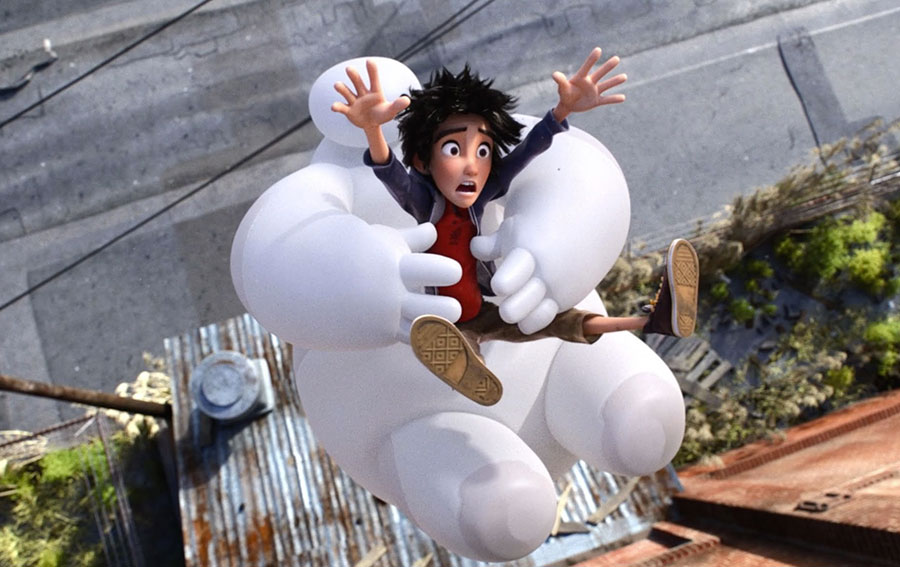Big Hero 6 is more than the sum of its recycled parts
Not every Disney movie is required to leave its audience a weeping, besotted mess. The animation titan’s latest feature, Big Hero 6, never reaches the soaring emotional vistas of The Lion King or even the relative poignancy of Frozen or Wreck-It Ralph, but that doesn’t stop it from being a playful, charming, visually resplendent adventure that tugs at your heartstrings without tearing them out by the roots (That’s Pixar’s job, as evidenced by the incinerator scene in Toy Story 3 and that devastating together-through-life montage in Up).

Excelsior · Big Hero 6 is the first Disney animated movie based on a Marvel property to come out since they acquired the company in 2009. — Photo courtesy of Walt Disney Pictures
Adapted from a lesser-known Marvel property written by Steven T. Seagle and Duncan Rouleau — the same creative duo who went on to produce Cartoon Network’s popular Ben 10 and Generator Rex animated shows at their studio Man of Action — and conceived as a westernized love letter to Japanese anime, Big Hero 6 centers on Hiro Hamada (voiced with great enthusiasm by Japanese-American actor Ryan Potter), a 14-year-old robotics prodigy living in the futuristic megalopolis of San Fransokyo (apparently California has fallen into the sea and collided with Japan by this point) with his ditzy Aunt Cass (Maya Rudolph) and equally brilliant older brother Tadashi (Daniel Henney).
The film, co-directed by Don Hall and Chris Williams, opens in the midst of a fraternal power struggle. After catching Hiro squandering his talents on illegal underground robot fights, Tadashi takes his gifted but aimless sibling on a tour of the local university, a future-tech wonderland that combines the scholarly setting of MIT with the mechanical marvels of Tony Stark’s workshop. Hiro, inspired by what he sees, decides it’s now his dream to attend this “nerd school,” and Tadashi and his merry band of misfits pledge to help him win the local science fair in a bid to impress the crotchety Professor Callaghan (the always welcome James Cromwell).
Of course, any Disney movie with a setup this aggressively mundane has to be heading towards an emotional vertical loop. Sure enough, tragedy strikes at the science fair and Tadashi dies in a mysterious explosion (Disney purposely included this plot point in the trailers in order to forewarn more sensitive viewers). Hiro, emotionally hobbled by the loss of the man who practically raised him, shuts himself off from the world and wallows in his grief until he unwittingly activates his brother’s final invention: an inflatable robotic healthcare provider named Baymax (Scott Adsit, whose not-quite-deadpan delivery is oddly endearing).
Hoping to improve Hiro’s emotional wellbeing, the automated caregiver agrees to help the boy investigate Tadashi’s death, and before long the two would-be heroes are on the trail of a sinister masked man — no kidding, he wears an antique Kabuki mask — who might have triggered the deadly explosion as a diversion to steal Hiro’s groundbreaking science fair project: an army of swarming microbots that can form nearly any shape or substance.
Once it becomes clear that a legitimate super-villain is on the loose, Big Hero 6 loses interest in its sweet-natured but overly familiar “a boy and his robot” dynamic — overly familiar in that it borrows several key story elements from Brad Bird’s supremely underrated 1999 gem The Iron Giant — and becomes a full-tilt superhero origin story that wouldn’t feel out of place in the live-action Marvel Cinematic Universe, complete with high-tech costumes, a team of wisecracking crime-fighters (their individual personalities are often eerily reminiscent of Hiccup’s Viking gang in DreamWorks’ How to Train Your Dragon movies, right down to the use of T.J. Miller’s character as easy-bake comic relief) and a never-ending barrage of spectacular battle sequences. This tonal shift can’t help but feel a tad jarring, particularly when Hiro redesigns the cuddly, soft-spoken Baymax as a do-it-yourself battle bot and reveals a hitherto unmentioned vengeful streak that would have proven a lot more interesting if the movie wasn’t so quick to reign in the behavior.
The third act wisely returns the focus to the relationship between Hiro and Baymax, skillfully restoring the balance between explosive action and earnest sentiment, and the film ends on a nicely cathartic note that simultaneously leaves the door wide open for future sequels. This strong ending erases many of the picture’s more glaring flaws, but there’s still a big one worth mentioning. For a movie whose main theme seems to be overcoming the loss of a loved one, Big Hero 6 is curiously unwilling to commit to its most emotional moments, juxtaposing scenes of intense bereavement with physical sight gags and goofy one-liners from its various side characters. Compare that to The Lion King, which gave its viewers several minutes to absorb the traumatic death of Mufasa before the first appearance of Timon and Pumbaa, the animal kingdom’s answer to Rosencrantz and Guildenstern. Remember this, prospective screenwriters: Even the Ritalin generation needs time to grieve.
Big Hero 6 is the first Disney animated film to feature Marvel characters since the Mouse House acquired the company back in 2009, and it definitely feels like it owes more to Stan Lee and Jack Kirby than Uncle Walt. The movie is strewn with obscure comics references, from a character’s prized action figure collection to a post-credits scene that would be criminal to spoil, yet it also boasts Disney’s patented blend of humor and heart. It’s also one of the most visually striking animated movies to come along in quite some time. San Fransokyo in particular is stunning to behold, a breathtaking synthesis of Los Angeles in Ridley Scott’s Blade Runner and Neo-Tokyo in Katsuhiro Otomo’s Akira. Like the rest of Big Hero 6, it’s clearly made of recycled parts, but there’s no denying it wears them with style.
Landon McDonald is a graduate student studying public relations. His column, “Screen Break,” runs Fridays.

